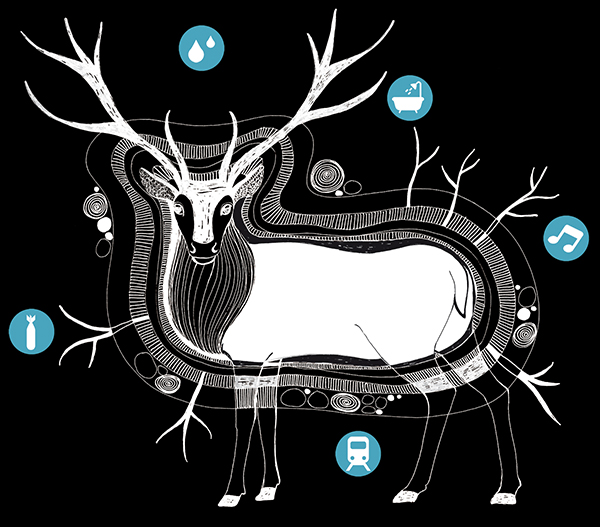The diurno was below ground, and he had to go down a flight of winding stairs. Down there he discovered a maze of white-tiled corridors and any number of doors. A dozen hearty-looking, 50-year-old women in light blue aprons with kerchiefs on their heads trotted up and down hauling dirty towels, buckets of disinfectant, scrub brushes for the tubs.
Luciano Bianciardi, L'integrazione
Alberghi diurni
Reaching the height of their popularity in the 1920s, the "alberghi diurni were" built underground. They were public toilets that offered residents and travelers washing and shaving facilities and a variety of services related primarily to personal hygiene.
In an age when few homes could boast a bathroom, they proposed a rather unique urban vision:
they married a vertical concept of the city with an intensive use of space.
il Cobianchi
Alberghi diurni are associated with the work of the entrepreneur Cleopatro Cobianchi, whose company grew to handle fifteen businesses of this type all over the country .
One of these, which opened in 1924, was based in Milan near the Cathedral .
The "Cobianchi" of Milan was the diurno to which Bianciardi was referring in "L'integrazione," and Carlo Lizzani later adapted that scene for the film "It’s a Hard Life", based on another of Bianciardi’s books.
Albergo Diurno of Porta Venezia
clicca con il tasto destro del mouse su "download" e seleziona la voce "salva oggetto con nome..." per scaricare l'audiodocumentario
Albergo Diurno of Porta Venezia - info about the audio documentary
The Albergo Diurno of Porta Venezia was open during the Giornate FAI di Primavera of March 22-23, 2014. The greater part of the audio documentary stems from that occasion. The documentary also includes two interviews with the local tradespeople.
The audio documentary was produced by Chiara Campara, Matteo Ninni and Carlo Tartivita, who conducted and assembled the interviews. The music is from Le Gros Ballon.
There is no english version of the audio documentary.
As regards the Cobianchi of piazza Duomo, it remains almost completely intact structurally, still boasting much of the original ornamentation.
Opened in 1926, the Albergo Diurno of Porta Venezia was located in a populous district and thanks to the proximity of the old railway station (then located in the piazza della Repubblica) and the terminus of the Milan-Monza tram, it attracted a steady stream of travelers.
In addition to bathrooms and showers, the albergo diurno was home to various beauty salons (a barbershop, a hairdresser, a manicure and pedicure shop), but also other businesses, including a travel agency, a photo studio, a bank branch and a typing service, as well as a mailbox.
A Noble father
The uniqueness of the Porta Venezia diurno is due not only to its conservation, but also to its lineage:
the decorative elements and general design are attributed to Piero Portaluppi, a Milanese architect active in the first half of the twentieth century, and the force behind several projects in the Porta Venezia neighborhood.
Between the past and the future
In the 70’s and 80’s, when a bathroom in the house had ceased to be a luxury, the alberghi diurni fell on hard times.
In 1985 the company that held the rights to the Porta Venezia diurno failed, and the City of Milan handed the management of the area over to the merchants already present there.
By 1986 the situation had worsened, and only a men’s hairdresser remained. In 2003 the diurno finally closed its doors.
In the years that followed various options were proposed for salvaging the structure, but it was not until 2015 that an agreement was signed between the City and the Fondo Ambiente Italiano for the restoration and re-opening of the Porta Venezia diurno.
Navigation info
On your journey you can control the playback of audio and video files with the menu navigation buttons located at the top of each page of Sotterranea.
Pausa / Play: both the video and the audio will start and stop based on the positioning of the page. You can also pause a video by clicking on the play area; clicking it again will resume play.
Volume: click on the buttons to raise and lower the volume.
Full screen: this button enables viewing in full screen.
Buffering: this button controls the percentage of the video buffered .
Video quality: the videos play in standard definition (SD); to access versions in high definition, click on the HD button.
And that’s the end of this route [info on the contents],
choose another route to explore!
The Albergo Diurno of Porta Venezia - Info on the contents of this route
The quote from Luciano Bianciardi comes from the book L'integrazione ublished in 1960 by Bompiani Publishing, and subsequently by Feltrinelli Publishing.
The video was shot at the Albergo Diurno of Porta Venezia.

explore theAlbergo Diurno,